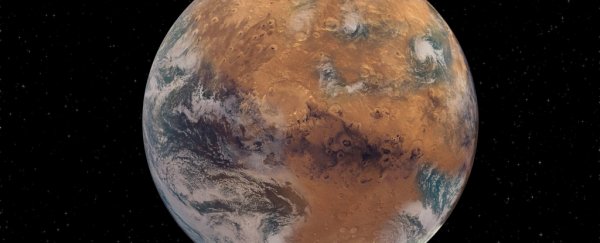We often talk about the strong similarities between Earth and Mars, but it's the differences that are likely behind why one planet has life and the other doesn't – at least, no life we've found so far.
Specifically, new research suggests it could be down to the size discrepancy. The diameter of Mars is just 53 percent that of Earth's (just over half the size), and that would make it impossible for Mars to hang onto volatiles that we know are vital for life – such as water.
"Mars's fate was decided from the beginning," says planetary scientist Kun Wang of Washington University in St. Louis.
"There is likely a threshold on the size requirements of rocky planets to retain enough water to enable habitability and plate tectonics, with mass exceeding that of Mars."
Although there are many differences between Earth and other terrestrial planets in the Solar System, it can be difficult to ascertain which factors are conducive to the emergence of life, and which factors hinder it.
But we can look at some of the things life on Earth needs in order to exist, and work from there.
One thing that life on Earth requires is liquid water, so conditions that enable the presence of liquid water is one of the key items on the planet habitability checklist. We know that Mars used to have surface water – we've seen evidence of it in Martian meteorites that have made their way from Earth, excavated from the red planet when the Solar System was still young. Today, however, Mars is dusty, dry and desolate, and any water on its surface is frozen.
The transition from a relatively wet planet to arid dustbowl is sometimes attributed to Mars's lost magnetic field. But it's possible that other factors play a role in the retention of volatiles, such as the surface gravity of a cosmic body; Earth's gravity, for reference, is 2.66 times that of Mars's. So Wang and his team set about investigating.
Specifically, they started looking at the abundances of the moderately volatile element potassium on various Solar System objects, using it as a tracer for other volatile elements and compounds.
That's because potassium isotope ratios are a strong proxy for volatile depletion in planetary interiors, because they are insensitive to igneous processes and impact-induced vaporization.
"Martian meteorites are the only samples available to us to study the chemical makeup of the bulk Mars," Wang says.
"Those Martian meteorites have ages varying from several hundred millions to 4 billion years and recorded Mars's volatile evolution history. Through measuring the isotopes of moderately volatile elements, such as potassium, we can infer the degree of volatile depletion of bulk planets and make comparisons between different Solar System bodies."
The team studied the isotope compositions of potassium in 20 Mars meteorites, chosen because they seem to be representative of Mars's bulk silicate composition. These compositions were then compared to the known bulk silicate compositions of three other inner Solar System objects of varying masses – Earth, the Moon, and the asteroid Vesta.
The results showed that Mars lost more volatiles than Earth did during its formation, but retained more than the Moon and Vesta, both of which are significantly smaller and drier than Mars.
"The reason for far lower abundances of volatile elements and their compounds in differentiated planets than in primitive undifferentiated meteorites has been a longstanding question," says planetary scientist Katharina Lodders of Washington University.
"The finding of the correlation of potassium isotopic compositions with planet gravity is a novel discovery with important quantitative implications for when and how the differentiated planets received and lost their volatiles."
This has implications for our understanding of the planet's history, the researchers said. Previous research has found that Mars was once very soggy indeed. This new correlation between gravity and volatile retention might help place constraints on just how much water Mars once had.
Additionally, the finding has implications for our search for habitable worlds outside the Solar System. One factor that influences the presence of liquid water on a planetary surface is its temperature, related to its proximity to the host star. Too close and water evaporates; too far, and it freezes.
We can also measure the sizes and masses of exoplanets, based on how much starlight they block when they move between us and the star, and how much the star moves in its mutual orbit with the exoplanet. So the team's work could help us rule out exoplanets that are too small for liquid water.
"The size of an exoplanet is one of the parameters that is easiest to determine," Wang said.
"Based on size and mass, we now know whether an exoplanet is a candidate for life, because a first-order determining factor for volatile retention is size."
The research has been published in PNAS.
